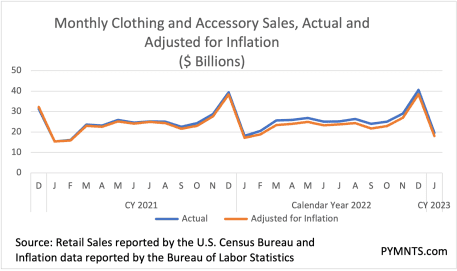
First the big-ticket items.
Then, consumers may throttle back on what they spend on … well, everything else.
To that end, as reported on Wednesday (March 15), the latest retail sales data show that U.S. consumers are dialing back on buying durable goods. And while spending is still resilient in a number of categories we might classify as “everyday spend” — well, the pressure’s on.
The data show that retail sales slipped in February, by 0.4%, from January’s levels, where January’s retail sales gain was a revised 3.2%.
And digging into the Commerce Department’s data which are seasonally adjusted (which includes adjustments for holiday and trading day differences), we see that a few categories show pullbacks that outstrip that 0.4% slide. Spending at motor vehicles and parts dealers was down 1.8% month over month. Spending at home furnishing stored slipped by 2.5%.

Consumers also spent less on clothing — curbing their purchases here by 0.8%. PYMNTS’ own proprietary research shows that as late as January 2023, spending on clothing is declining, perhaps as expected, but signaling pressure on retailers nonetheless. Our stats are not seasonally adjusted (in contrast to Wednesday’s data from the government), but do adjust for inflation, and as seen in the accompanying charts, the trends and directions are in evidence — namely, things are headed south.
Dining out also took a hit, as spending at food services and drinking establishments was down 2.2%. Department stores saw a relatively outsized decline, as sales here were down 4% from January’s levels.
For now, individuals and families are still opening up their pocketbooks here and there: Spending at grocery stores was up 0.6%.
But inflation has a real and lasting impact as to what really happens when it comes to keeping the fridge stocked. As PYMNTS data show, when adjusted for inflation, the “real” spending is actually down year on year. On a TTM basis through January 2023, grocery is up 7.4% but decreased by 3.9% on a real basis.

Elsewhere, people bought more at electronics and appliance stores, up 0.3%. But when we look year over year, this is one of the only categories that has seen an outright decline, off 2.8% from last year. The read across here is that consumers may have satisfied whatever demand had been in place here, especially into the end of the year and the holiday shopping season.
These data points show just how stretched consumers budgets really are. By pulling back on large-ticket purchases — cars, for example — we might posit that consumers are budgeting with “low hanging” fruit in sight. In other words, it’s a bit easier to rein in spending on items that are last years, cost thousands of dollars, and, arguably, can “wait till things cool down a bit.” Separate PYMNTS research confirms this, as we found that almost 55% of consumers didn’t buy expensive clothing or accessories last year and don’t plan to this year. Similarly, 55% of those surveyed did not buy a car in 2022 and say they likely won’t this year.
The question is: What comes next? If 70% if consumers expect to see significant price increases through the next year, February’s sales decline may be just the start of a trend, as households retrench and redefine what they must have — and what they can do without.